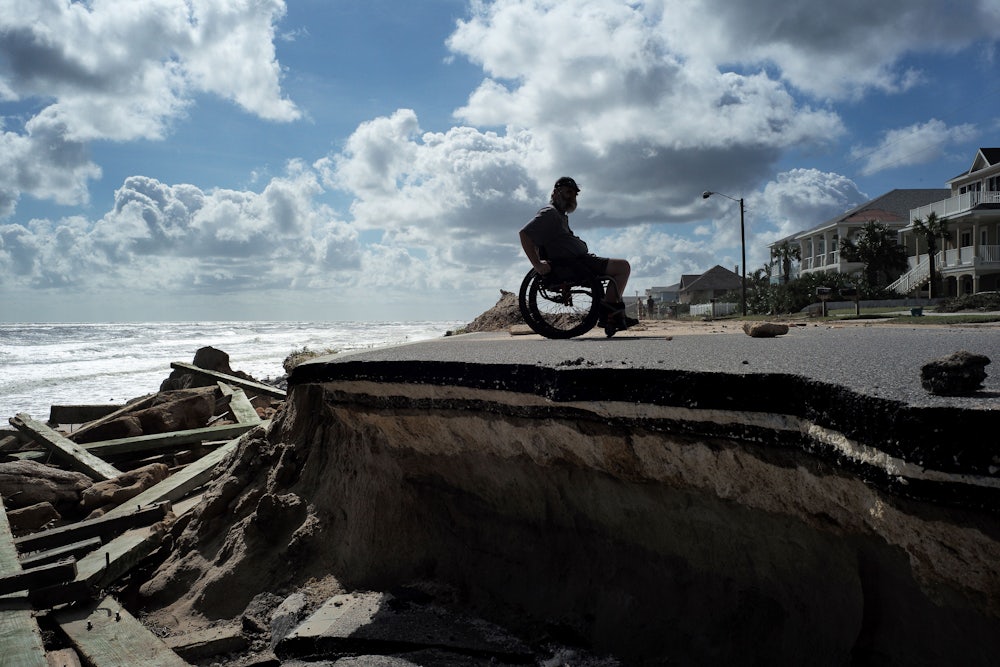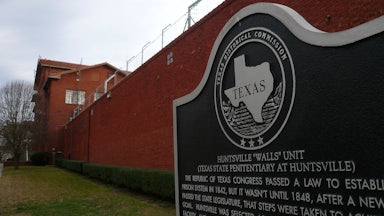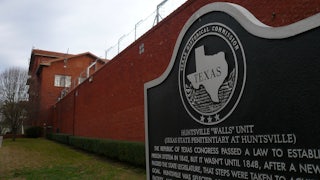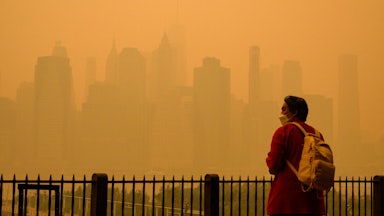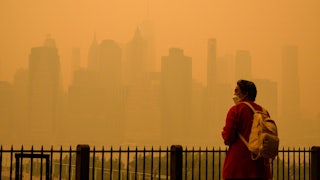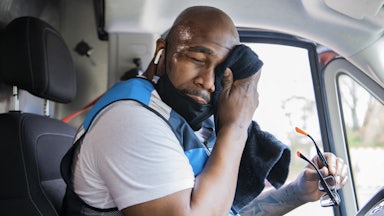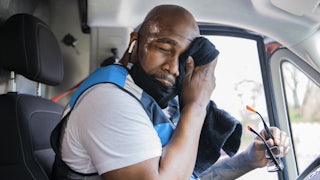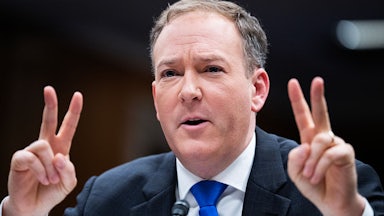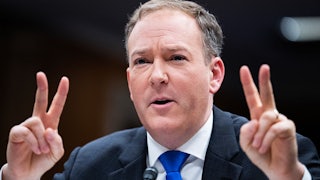As Hurricane Matthew bore down on the Atlantic Coast in October 2016, Mary Fashik was forced to leave her home in Brunswick, Georgia, for a communal shelter in Valdosta, about a two-hour drive inland.
Fashik is an ambulatory wheelchair user, and the cots at the emergency shelter were not designed with bodies like hers in mind. She could not lie down on the cot she had been allocated. The following night, when a good Samaritan offered her an air mattress and she needed help transferring to and from it, she learned that shelter staff were not trained to help transfer a wheelchair user. During botched transfers, Fashik sustained bruises under her arms and injuries to her hip and knee that required months of physical therapy to treat.
“I did not sleep the entire night,” she told me. Fashik said the experience made her realize how little standard disaster-preparedness protocols consider the needs of disabled people, which she said reflects how little lives like hers seem to be valued.
“It is very scary to know that my life is not deemed as valuable as someone who is nondisabled,” she said.
Many of America’s 42.5 million disabled people who have faced hazards like extreme weather, hurricanes, and wildfires in recent years have stories like Fashik’s, where the essential resources needed during an emergency were inaccessible to them. These shortcomings in the nation’s emergency preparedness, response, and recovery systems will only become more pronounced and deadlier for disabled folks as climate change–related disasters become more intense and widespread. Disabled people are already two to four times more likely to die or sustain critical injuries during a disaster.
Experts say the root cause of this condemnable statistic is disabled people being blocked from every stage of the emergency management process. “We are excluded from the tables where these conversations are happening and the decisions are being made,” said Germán Parodi, co-executive director of the Partnership for Inclusive Disaster Strategies, or PIDS, a disability-led organization focused on ensuring equity for disabled people before, during, and after emergencies.
This is not a new problem. In a statement to the United States Senate Special Committee on Aging in 2017, Paul Timmons, then president of Portlight Inclusive Disaster Strategies, a predecessor to PIDS, attributed this exclusion to widely held erroneous and stigmatizing beliefs about disability and aging.
Fashik said she experienced some of these misconceptions when sheltering from Hurricane Mathew in 2016. Although she instructed shelter staff on how best to help her transfer from the floor to her feet, she said she was ignored. “They think they know best because they’re nondisabled,” she said. “I have impaired speech, and people equate my impaired speech to my intelligence, so they don’t listen, or they don’t try to listen.”
When disaster strikes, local and state governments respond first. These governments are obligated to make their disaster responses accessible, according to the Americans With Disabilities Act of 1990 and the Rehabilitation Act of 1973. However, this is seldom accomplished, experts and disaster survivors like Fashik say.
For examples of this kind of poor planning at the local level, look no further than the multiple lawsuits filed against governments or officials alleging they discriminated against disabled people by failing to consider and respond to their needs during emergencies. One of the earliest such cases was a federal class action lawsuit against the City of New York and Mayor Michael Bloomberg in 2011 following Hurricane Irene. Plaintiffs included disabled New Yorkers who could not access emergency housing or had been turned away from shelters: These shelters, the complaint says, had insufficient signage for blind and low-vision persons, and ramps that wheelchair users needed were behind locked gates. The city’s official evacuation maps featured text too small for some users to read, and televised emergency announcements did not have American Sign Language interpreters. In November 2013, the U.S. District Court for the Southern District of New York ruled that New York City had discriminated against people with disabilities in its failure to plan for their needs.
Another issue in the New York City case was the lack of accessible transportation to facilitate evacuations. Bloomberg ordered a shutdown of transportation services hours before Hurricane Irene made landfall and told New Yorkers to use cabs to reach shelters. However, only 1.8 percent of yellow taxicabs and only 0.2 percent of other for-hire vehicles were accessible to wheelchair users at the time. Fashik said she evacuated in a personal vehicle during Hurricane Matthew, but she no longer has a car that can accommodate her wheelchair; she said she does not know how she will leave if she is told to evacuate this hurricane season. People with travel-limiting disabilities who do not have accessible transportation also struggle to reach distribution points for needed supplies following a disaster.
This year, Disability Rights Texas filed a federal lawsuit against the City of San Antonio on behalf of nine plaintiffs, including four children, who were forced to shelter in place during 2021’s devastating winter storm because the city did not have shelters that were accessible to them. The storm caused sustained power outages, which left plaintiffs unable to refrigerate medications or charge assistive devices and durable medical equipment, including motorized wheelchairs and feeding pumps. Over 2.9 million Medicare beneficiaries nationwide rely on electricity-dependent durable medical and assistive equipment and devices.
Stephanie Duke, supervising attorney and disaster resilience coordinator at DRTX, said the plaintiffs in the Texas case are not seeking damages. Rather, they want to ensure the city includes disabled people in its planning process and addresses their needs. “They want to know that the next time something happens, they’re going to have access to services,” said Duke. “To do that, you have to fix the planning process.”
The federal government, unfortunately, has historically not been much better than the states at helping disabled people through disasters. The Federal Emergency Management Agency only responds once the president of the United States declares a disaster. FEMA only appointed a disability coordinator in 2007 as a requirement of a reform passed in the wake of Hurricane Katrina, after that storm laid bare the stark inequalities in disaster preparedness and response for aging and disabled Americans. More than 70 percent of those who died in Louisiana were over 60, and younger disabled people were also overrepresented among hurricane-related deaths.
It was only in 2010 that FEMA launched an Office of Disability Integration and Coordination, which made coordinating with stakeholders to better serve disabled people part of its core mandate. Unfortunately, until recently, Parodi said there had been “little engagement from ODIC to the disability community, which creates the failures that we see.” Under new director Sherman Gillums Jr., appointed last August, Parodi said he has seen some improvement. On his first deployment as ODIC director to response operations for Hurricane Fiona in September 2022, Parodi said Gillums was quick to meet with PIDS responders and local Centers for Independent Living representatives. Gillums also often joins PIDS’s weekly national stakeholders call—a basic move but a step up from his predecessors. (Gillums’s office did not respond to multiple requests for an interview for this story.)
Individuals who have interacted with FEMA following recent disasters describe the experience as one of frustration and despair. “I feel like FEMA sets you up to fail,” said Marcella Ruikis, who lost her home in Talent, Oregon, in 2020’s Almeda Drive Fire. Ruikis’s mother, Susan Wells, also lost her home and its built-in assistive equipment, including a ramp and grab bars, that had allowed her to live independently.
The pair stayed in a series of temporary homes ill suited to Wells’s access needs as they sought financial assistance from FEMA, a Kafkaesque process that Ruikis said required months of faxing and mailing paperwork and following up via phone, during which she was often given conflicting information. While FEMA’s Assistance for Other Needs program is meant to provide funds to replace assistive equipment, Ruikis said she and Wells paid more than $700 out of pocket to install a wheelchair ramp when they finally found a longer-term rental.
Fashik said she also shouldered significant out-of-pocket expenses when she evacuated to a hotel during Hurricane Irma in 2017. If she is told to evacuate this year, she will again seek accommodation in a hotel: Communal shelters are unsafe for her as an immunocompromised person amid the ongoing Covid-19 pandemic.
Parodi underscores that many disabled people live on fixed incomes, making the added costs of disaster preparedness and response more taxing or even unattainable. “Many people with disabilities do not have savings accounts or rainy-day funds to evacuate to a safe space ahead of an oncoming disaster,” he said.
Following the Almeda Drive Fire, Wells’s health deteriorated to the point that she could no longer live independently. “The stress, the moving, and the insecurity—her health just started going down,” said Ruikis. Wells passed away in July 2022, less than two years after the fire. Ruikis said she felt helpless in the last months of her life as the pair struggled to access needed FEMA assistance. (In response to multiple requests for comment for this story, FEMA press officials directed me to visit the ODIC homepage to “learn about the work of [the ODIC].”)
For Ruikis and Wells, community-based organizations, friends, and even Wells’s doctor offered support where government agencies did not. This is the case for many disabled people, as independent organizations, many of them disability-led, work to plug gaps in the nation’s disaster preparedness, response, and recovery systems. Representatives at these organizations say they want resources to serve their communities and a seat at the table to shape national conversations about emergency management.
The Real Emergency Access for Aging and Disability Inclusion for Disasters Act could be a step in the right direction. Introduced in Congress in 2019, 2021, and again this year, the legislation would establish a National Commission on Disability Rights and Disasters to study the needs of disabled and aging Americans and others with access and functional needs and make recommendations for best practices to ensure these populations are included in all aspects of disaster preparedness. “We hope [the legislation] would support some of the community resilience activities that we provide and create awareness about disability and the disaster-specific technical assistance and training needed,” said Parodi.
Until more is done on the federal level, however, disabled folks will continue to turn to their community in times of need—a support network that the government would do well to engage.
“We’re the solution in most cases,” said Shaylin Sluzalis, co-executive director of PIDS. “If we’re involved in every aspect of the response—planning, mitigation, and recovery—then there are going to be better solutions.”
